
Cologne Cathedral is a cathedral in Cologne, North Rhine-Westphalia belonging to the Catholic Church. It is the seat of the Archbishop of Cologne and of the administration of the Archdiocese of Cologne. It is a renowned monument of German Catholicism and Gothic architecture and was declared a World Heritage Site in 1996. It is Germany's most visited landmark, attracting an average of 6 million people a year. At 157 m (515 ft), the cathedral is the tallest twin-spired church in the world, the second tallest church in Europe after Ulm Minster, and the third tallest church of any kind in the world.

The Berlin Palace, formally the Royal Palace and also known as the City Palace, is a large building adjacent to Berlin Cathedral and the Museum Island in the Mitte area of Berlin. It was the main residence of the House of Hohenzollern from 1443 to 1918. Expanded by order of Frederick I of Prussia according to plans by Andreas Schlüter from 1689 to 1713, it was thereafter considered a major work of Prussian Baroque architecture. The royal palace became one of Berlin’s largest buildings and shaped the cityscape with its 60-meter-high (200 ft) dome erected in 1845.

Friedrichshain is a quarter (Ortsteil) of the borough of Friedrichshain-Kreuzberg in Berlin, Germany. From its creation in 1920 until 2001, it was a freestanding city borough. Formerly part of East Berlin, it is adjacent to Mitte, Prenzlauer Berg, Kreuzberg and Lichtenberg.
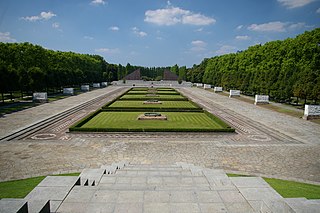
Treptower Park is a park alongside the river Spree in Alt-Treptow, in the district of Treptow-Köpenick, south of central Berlin.

The German Historical Museum, known by the acronym DHM, is a museum in Berlin, Germany devoted to German history. It describes itself as a place of "enlightenment and understanding of the shared history of Germans and Europeans". It is often viewed as one of the most important museums in Berlin and is one of the most frequented. The museum is located in the 17th-century Zeughaus (armoury) on the Unter den Linden, just across the Spree from Museum Island. The museum's attached Exhibition Hall was designed by I. M. Pei in the late 20th century. The Zeughaus is closed for renovation, while the Exhibition Hall remains open.
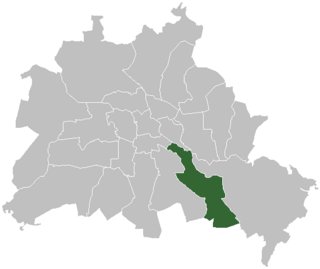
Treptow was a former borough in the southeast of Berlin. It merged with Köpenick to form Treptow-Köpenick in 2001.
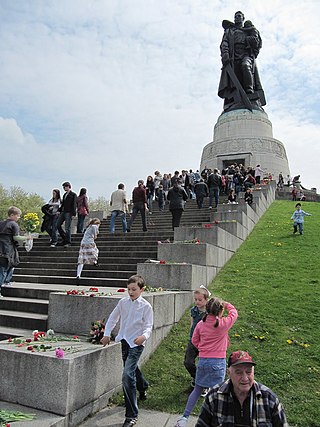
The Soviet War Memorial is a war memorial and military cemetery in Berlin's Treptower Park. It was built to the design of the Soviet architect Yakov Belopolsky to commemorate 7,000 of the 80,000 Red Army soldiers who fell in the Battle of Berlin in April–May 1945. It opened four years after the end of World War II in Europe, on 8 May 1949. The Memorial served as the central war memorial of East Germany.
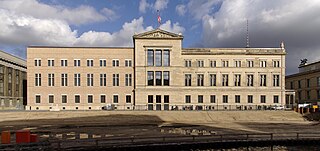
The Neues Museum is a listed building on the Museum Island in the historic centre of Berlin, Germany. Built from 1843 to 1855 by order of King Frederick William IV of Prussia in Neoclassical and Renaissance Revival styles, it is considered as the major work of Friedrich August Stüler. After suffering damage in World War II and decay in East Germany, it was restored from 1999 to 2009 by David Chipperfield. Currently, the Neues Museum is home to the Egyptian Museum, the Papyrussammlung, the Museum für Vor- und Frühgeschichte and parts of the Antikensammlung. As part of the Museum Island complex, the museum was inscribed on the UNESCO World Heritage List in 1999 because of its outstanding architecture and testimony to the evolution of museums as a cultural phenomenon.

Bundesautobahn 100 is an Autobahn in Germany.
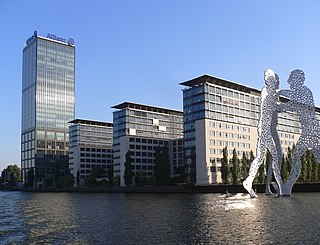
Alt-Treptow is a German locality in the borough of Treptow-Köpenick in Berlin. Known also as Treptow it was, until 2001, the main and the eponymous locality of the former Treptow borough.
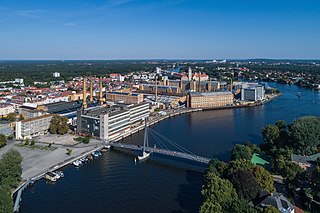
Oberschöneweide is a German locality (Ortsteil) within the Berlin borough (Bezirk) of Treptow-Köpenick. It is, with Niederschöneweide, part of the geographic area of Schöneweide. Until 2001 it was part of the former borough of Köpenick.

Niederschöneweide is a German locality (Ortsteil) within the Berlin borough (Bezirk) of Treptow-Köpenick. It is, with Oberschöneweide, part of the geographic quarter of Schöneweide. Until 2001 it was part of the former borough of Treptow.

Plänterwald is a German locality (Ortsteil) within the Berlin borough (Bezirk) of Treptow-Köpenick. Until 2001 it was part of the former borough of Treptow and the site of its former town hall.

Mediaspree is one of the largest property investment projects in Berlin. It aims to establish telecommunication and media companies along a section of the banks of the river Spree as well as to implement an urban renewal of the surrounding area. So far, for the most part, unused or temporarily occupied real estate is to be converted into office buildings, lofts, hotels, and other new structures.

The Neuer Marstall is a listed historic building in Berlin, Germany located on the Schloßplatz and the Spree River. Completed in 1901 and facing the former Royal Palace, the neo-Baroque "New Stables" once sheltered the Royal equerry, horses and carriages of Imperial Germany. The complex also included three enclosed courtyards, a riding school, and the Knights College.

Köllnischer Park is a public park located near the River Spree in Mitte, Berlin. It is named after Cölln, one of the two cities which came together to form Berlin; the park location was originally just outside it. Approximately 1 hectare in area, the park came into existence in the 18th and 19th centuries on the site of fortifications. It was redesigned as a public park in 1869–1873 and was further modified in the 20th century with the addition of first a bear enclosure, the Bärenzwinger, and later a permanent exhibition of sculpture, the Lapidary. The park is a registered Berlin landmark.

The Federal Chancellery in Berlin is the official seat and residence of the chancellor of Germany as well as their executive office, the German Chancellery. As part of the move of the German Federal Government from Bonn to Berlin, the office moved into the new building planned by the architects Axel Schultes and Charlotte Frank. The building, which is the largest government headquarters in the world, is part of the "Federal Ribbon" in the Spreebogen. Its address is Willy-Brandt-Straße 1, located in the Tiergarten area of Berlin.
The New Uhyst Castle is located on the northern edge of the town of Uhyst in the Saxony district of Görlitz, Germany. It is located near the Spree river flowing through the village and borders the Bärwalder See Landscape Park. The castle grounds have a Baroque garden and an English landscape park.

The Karpfenteich in Berlin is an artificial body of water in the Berlin district of Alt-Treptow.



















